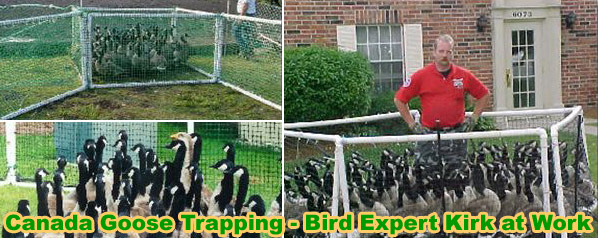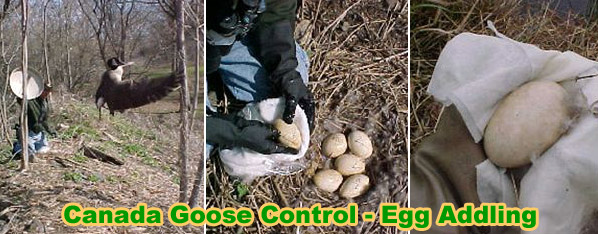- info@wildlife-removal.com
Call us for help in your town
Wildlife Removal Education
How to Get Rid of Canadian Geese
Need geese removal in your hometown? We service over 500 USA locations! Click here to hire us in your town and check prices - updated for year 2020.
Below is my advice for getting rid of a Canada Goose problem. However, if it proves ineffective in your case, you have the option to hire a Professional Goose Removal Company in
your area to take care of the problem. You may also email me with any questions you have.
We all enjoy the sight of geese overhead, signaling the coming or going of our coldest months. In a pond, lake or river, geese are also a majestic, impressive visual of coordination and communication.
Geese, however, can be an incredible nuisance bird especially due to their tendency to gather in mass quantities, and leave lots of goose poo everywhere. Some Canada geese have become non-migratory,
presenting a year-round problem for the places they decide to claim as homes.
Canada geese pose a problem to humans on many different levels. Not only do geese pass waste in large amounts, the waste matter is usually haphazard, and spans the entire territory the flock
has settled on. The specific grasses that serve as food for the Canada goose are quickly eaten, opening the banks of ponds and lakes to excessive erosion. Loss of crops due to long durations of stay,
and poor water quality caused by fecal matter runoff are also serious concerns. Canada geese have been known to attack people if they feel threatened, but a more deadly threat is that of geese flying
into the engines of aircraft and causing equipment failure.
The Canada goose returns to the same nesting sites every year. Once a goose problem, always a goose problem unless immediately handled with appropriate methods. Canada geese are protected under
multiple laws, so eliminating them will take some research and the help of a professional. You can't just shoot them.
The first stage of eliminating your goose problem is to try to eliminate the food source. If you have a flock of geese residing in your corn field, this is a moot point. Geese in an urban setting,
however, are more easily managed by preventing the public from offering handouts of food. Public interference, whether by deliberate feeding or poor garbage removal, is a huge hindrance when dealing with
a problematic flock of geese.

One practical way to handle geese is to capture and remove them. During one point of the year, geese are rendered flightless, and thus are more easily netted. Cannon nets are generally shot over a
grouping of Canada geese and then slowly reeled in. The object is to contain the geese without causing too much panic and thus injury to the birds. Often, a pond is baited with grain prior to netting to distract
the geese while they are obtained. Or, they can just be rounded up, herded basically, into pens!
Harassing geese is often allowed by law, and is the attempt to frighten them away from their current lodgings. Geese are so used to human interaction, however, that this tactic usually only works
for a short period of time before the flock adapts to the situation. Noise is also a tool used to deter birds from a specific location. Loud, periodic bursts of sound will frighten birds. Again, after a
period of usefulness, the geese tend to become desensitize to sound tactics.
Animal vs. animal efforts can work effectively. A well-trained dog can be invaluable against warding off geese. Many breeds work well, and of course, Border Collies are great at Canada Goose control! Birds of prey, commonly trained for hunting, can also be employed to discourage the
Canada goose from flying in. The downside to animal warding is that once the predatory animal is removed, the geese often come right back. But a good program of harassment by dogs really can convince them to move elsewhere. If
they do return, just call in the dogs again, and the geese will get the idea.
Relocating Canada geese can be challenging. The birds have a homing instinct that will draw them back to places they previously found favorable. If geese are relocated, the area should be as
enticing as possible, rich in food, water, and vegetation. Sometimes, even if all the pieces are in place, geese will still return to the place they were removed from.

Another legal tactic is egg addling. This process involves messing with a nest of eggs to make them infertile, so that a female goose wastes all her time sitting on a clutch of eggs that will never
hatch. If she knows that the eggs have been destroyed, she will just lay another nest full, so you must be fairly discreet about it. The eggs shouldn't look, smell, or feel different as a result of the addling.
One good method is to coat the eggs in corn oil, which deprives the embryo of oxygen, so it never develops.
Removing Canada geese is for professionals only. If harassment techniques do not work for you, use the directory of professionals for additional aid.
For other bird removal and control information, go to may main bird removal page.


















